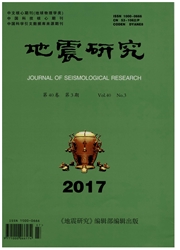

 中文摘要:
中文摘要:
The Hanyuan Town is located approximately 200 km from the macro-epicenter of the great Wenchuan earthquake. However, it is within the only Intensity Ⅷ zone, surrounded by a region of Intensity Ⅵ. The objective of this study was to investigate this high-intensity anomaly with respect to the site amplifications in the Hanyuan Town. The base inputs were derived from the records at a nearby strong-motion station because no records were available from the town. The characteristics of the subsurface formations and their dynamic properties at a typical site in the town were obtained by drilling, field tests and laboratory tests. Seismic response and parametric sensitivity analyses of the site were conducted using Shake 91, and the results were compared with the provisions for rare earthquakes from the Chinese Code for Seismic Design of Buildings(GBJ11-89). The results showed that the average peak acceleration at the site during the Wenchuan earthquake is similar to the code-specified value under rare earthquakes, that the corresponding spectral accelerations for periods between approximately 0.35 and 0.75 s are significantly stronger than those specified by the code and that the average amplification factor at the site is significantly higher than the mean value of the site class. These findings indicate that the high-intensity anomaly in the town was primarily caused by site amplification effects from the unique structure of the soil strata.
 英文摘要:
英文摘要:
The Hanyuan Town is located approximately 200 km from the macro-epicenter of the great Wenchuan earthquake. However, it is within the only Intensity VIII zone, surrounded by a region of Intensity VI. The objective of this study was to investigate this high-intensity anomaly with respect to the site amplifications in the Hanyuan Town. The base inputs were derived from the records at a nearby strong-motion station because no records were available from the town. The characteristics of the subsurface formations and their dynamic properties at a typical site in the town were obtained by drilling, field tests and laboratory tests. Seismic response and parametric sensitivity analyses of the site were conducted using Shake 91, and the results were compared with the provisions for rare earthquakes from the Chinese Code for Seismic Design of Buildings (GBJ11-89). The results showed that the average peak acceleration at the site during the Wenchuan earthquake is similar to the code-specified value under rare earthquakes, that the corresponding spectral accelerations for periods betwcen approximately 0.35 and 0.75 s are significantly stronger than those specified by the code and that the average amplification factor at the site is significantly higher than the mean value of the site class. These findings indicate that the high-intensity anomaly in the town was primarily caused by site amplification effects from the unique structure of the soil strata.
 同期刊论文项目
同期刊论文项目
 同项目期刊论文
同项目期刊论文
 期刊信息
期刊信息
